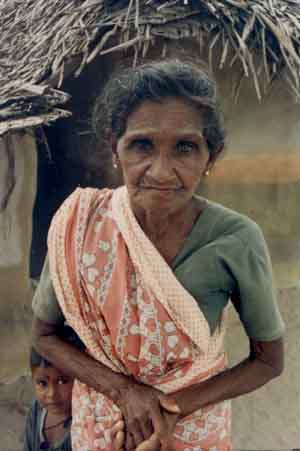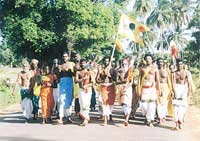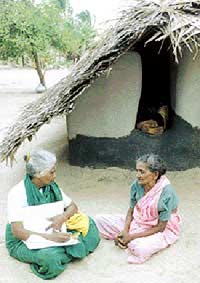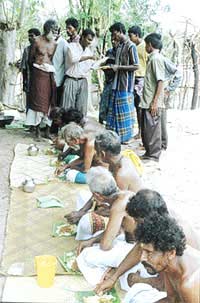
|
||||||||||||||||
|
| ||||||||||||||||
 Pada Yatra pilgrims promote Sri Lanka's peace process
National Vision to lay roadmap to peace and prosperity
|

|
| Bairavamuttu Ponnamma (75) of Palchenai, a coastal Vedda hamlet in Batticaloa District |
Setting aside politics for the sake of island-wide peace, justice and prosperity is exactly what the Pada Yatra swamis and swami ammas have been doing this year. Some have been helping the Committee for a National Vision, a joint Government and private sector body, to solicit the opinions and suggestions of villagers all along the route of the Pada Yatra throughout the remote North and East.
The National Vision aims to lay out a roadmap to a peaceful and prosperous Sri Lanka that is a multi-cultural, multi-ethnic, multi-faith, and plural society, where cultural diversity is recognized as a source of national wealth and strength.
This year traditional Kataragama Pada Yatra foot pilgrims on their long march from Mullaittivu to Kataragama have been collecting villagers' own appraisals of their village's problems and ideal solutions. The project aims to stimulate open discussions, collect villagers' insights, and forward results to the Committee for consideration and incorporation into a National Vision.
"The Pada Yatra swamis and swami ammas are doing yeoman service to the nation by helping us to collect villagers' perspectives, which differ from village to village," says National Vision Committee Chairman Dr. Devanesan Nesiah.
"The pilgrim-interviewers include male pilgrims who interview men, and women pilgrims who interview women villagers. The project has both Tamil and Sinhala language volunteers. The project has been interviewing men and women of the East Coast's Hindu, Buddhist, Christian and Muslim communities."
Coastal Veddas
Even Tamil-speaking east coastal Veddas are having their views heard in Colombo for the first time ever. For instance, one coastal Vedda matriarch, 75-year old Bairavamuttu Ponnamma, observed that her Vedda hamlet of Palchenai hamlet near Kathiraveli does not receive nearly the same level of Government attention and amenities that neighboring villages take for granted.
"In Palchenai there is no local employment except seasonal field labour. There is a school but no qualified teacher. Local officials pay visits but nothing ever gets done," she says. These are grievances that deserve to be rectified. Without justice and prosperity, the ‘peace' can only be temporary.
Most villages in the North and East are populated by Tamils. The survey, however, also visits Sinhala enclaves like Seruvila, whose inhabitants express optimism about the future, and only request that they be provided with adequate agricultural support services in order to live self-sufficiently in peace with neighboring Tamil and Muslim communities.
The pilot project, called ‘Let the Villagers be Heard', has already submitted field reports from Mullaittivu, Trincomalee and Batticaloa districts, and is now commencing interviews in Ampara District.
Some 500 foot pilgrims—mostly village elders—crossed Batticaloa District by the second week of July. Their numbers are expected to grow dramatically as the parties approach Pottuvil where the pilgrims assemble to purchase dry rations before beginning the week-long trek through Yala National Park.
The Kataragama Pada Yatra went into abeyance with the onset of ethnic conflict in 1983 until 1988 when the Kataragama Devotees Trust was established to revive and support ancient traditions of Kataragama, such as the Pada Yatra. This year is the sixteenth consecutive Pada Yatra sponsored by the Kataragama Devotees Trust with the support of villagers and officials at the national, district and local levels.
This article first appeared in The Sunday Island of 20 July 2003.
Patrick Harrigan (M.A., University of Michigan) has been the Kataragama Devotees Trust's Pada Yatra field representataive since 1988. The 2003 Pada Yatra was his 17th Kataragama Pada Yatra since 1972.
Tamil version of this article
"National Vision Committee convenes in Kataragama"
Pada Yatra 2003 begins June 8 | "Pada Yatra pilgrims promote peace"
|
| Living Heritage Trust ©2023 All Rights Reserved |


